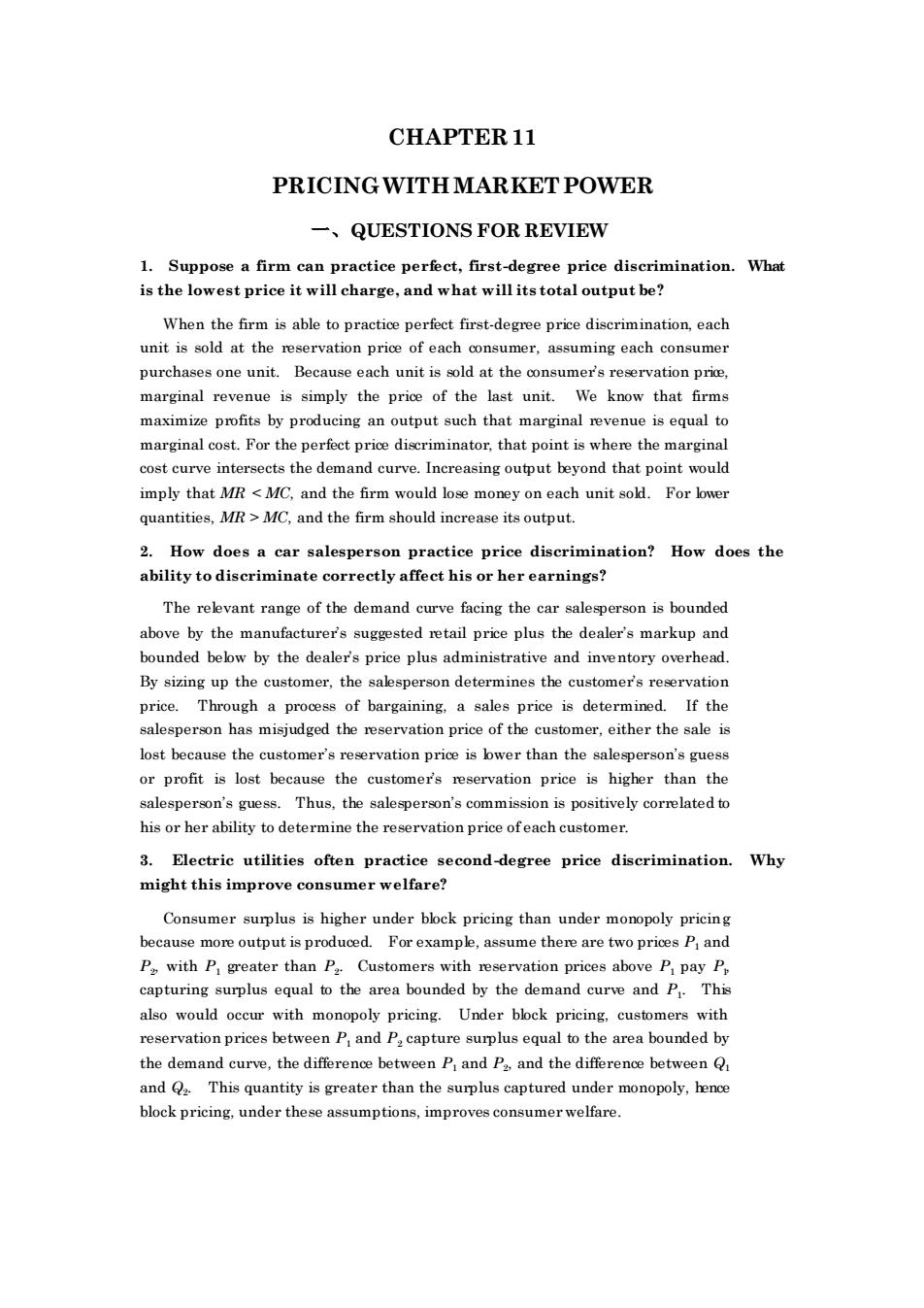正在加载图片...

CHAPTER 11 PRICING WITHMARKET POWER 一、QUESTIONS FOR REVIEW 1.Suppose a firm can practice perfect,first-degree price discrimination.What is the lowest price it will charge,and what will its total output be? When the firm is able to practice perfect first-degree price discrimination.each unit is sold at the reservation price of each consumer,assuming each consme purchases one unit.Bec ause e sume on pra marginal revenues simply the pri of the unit.We w that maximize profits by producing an output such that marginal revenue is equal to marginal cost.For the perfect price discriminator,that point is where the marginal cost curve intersects the demand curve.Increasing output beyond that point would imply that MR<MC,and the firm would o moneyo n each unit sol.For bwer quantities,MRMC.and the frm should increase itsouput. 2.How does a car salesperson practice price discrimination?How does the ability to discriminate correctly affect his or her earnings? The relevant range of the demand curve facing the car salesperson is bounded above by the manufacturer's suggested retail price plus the dealer's markup and bounded below by the dealer's price plus administrative and inventory overhead. By sizing up the customer,the rson determines the customers ervation price.of bargaining.als price determined. If the aalesperson has misjudged the reservation price of the customer,either the sale is lost because the customer's reservation price is bwer than the salesperson's guess or profit is lost because the customer's reservation price is higher than the correlated to Why Consumer surplus is higher under blck pricing than under monopoly pricing because more output is produced.For example,assume there are two prices P and P with P greater than P.Customers with reservation prices above P pay P. capturing surplus equal to the area bounded by the demand curve and P.This also would oc with monopoly pricing.Under blck pricing with reservation prices between Pand P capture surplus equa the demand curve,the difference between P and P and the difference between and This quantity is greater than the surplus captured under monopoly,hence block pricing.under these assumptions.improves consumer welfare.CHAPTER 11 PRICING WITH MARKET POWER 一、QUESTIONS FOR REVIEW 1. Suppose a firm can practice perfect, first-degree price discrimination. What is the lowest price it will charge, and what will its total output be? When the firm is able to practice perfect first-degree price discrimination, each unit is sold at the reservation price of each consumer, assuming each consumer purchases one unit. Because each unit is sold at the consumer’s reservation price, marginal revenue is simply the price of the last unit. We know that firms maximize profits by producing an output such that marginal revenue is equal to marginal cost. For the perfect price discriminator, that point is where the marginal cost curve intersects the demand curve. Increasing output beyond that point would imply that MR < MC, and the firm would lose money on each unit sold. For lower quantities, MR > MC, and the firm should increase its output. 2. How does a car salesperson practice price discrimination? How does the ability to discriminate correctly affect his or her earnings? The relevant range of the demand curve facing the car salesperson is bounded above by the manufacturer’s suggested retail price plus the dealer’s markup and bounded below by the dealer’s price plus administrative and inventory overhead. By sizing up the customer, the salesperson determines the customer’s reservation price. Through a process of bargaining, a sales price is determined. If the salesperson has misjudged the reservation price of the customer, either the sale is lost because the customer’s reservation price is lower than the salesperson’s guess or profit is lost because the customer’s reservation price is higher than the salesperson’s guess. Thus, the salesperson’s commission is positively correlated to his or her ability to determine the reservation price of each customer. 3. Electric utilities often practice second-degree price discrimination. Why might this improve consumer welfare? Consumer surplus is higher under block pricing than under monopoly pricing because more output is produced. For example, assume there are two prices P1 and P2 , with P1 greater than P2 . Customers with reservation prices above P1 pay P1 , capturing surplus equal to the area bounded by the demand curve and P1 . This also would occur with monopoly pricing. Under block pricing, customers with reservation prices between P1 and P2 capture surplus equal to the area bounded by the demand curve, the difference between P1 and P2 , and the difference between Q1 and Q2 . This quantity is greater than the surplus captured under monopoly, hence block pricing, under these assumptions, improves consumer welfare